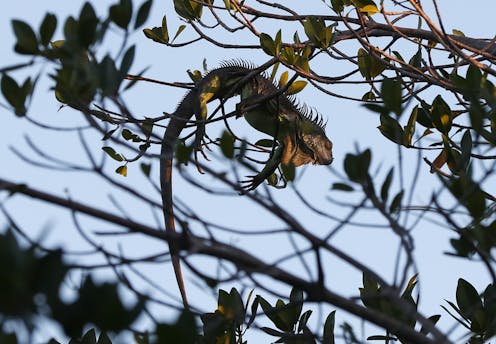If it's below 40 degrees in South Florida, the forecast calls for falling iguanas
Green iguanas are an invasive species that seem to be spreading and proliferating in Florida. Used to warmer temps, they switch into torpor mode when the mercury drops.

As temperatures were dipping this week, the National Weather Service issued freeze warnings for much of Florida and Georgia, adding a warning in South Florida for “falling iguanas.” University of Florida wildlife ecologist Frank Mazzotti explains the physiology of cold iguanas and why many people in Florida aren’t shedding tears for the iguana-cicles lying around the region.
What happens to iguanas when temps drop?
When temperatures fall into the 40s and 30s, green iguanas become cold-stunned. They enter what’s called a state of torpor. Their breathing slows down and so does their metabolism.
Used to more balmy conditions, this is how tropical reptiles protect themselves from cold temperatures. Torpor is an involuntary response, and the animals trade torpor’s benefit of conserving heat in cold conditions for an increased risk of being snagged by a predator.
Torpor causes green iguanas to lose muscle control, and since they live in trees, they fall out of trees. A several pound iguana falling on your head would definitely get your attention.
What should you do if you see a dazed iguana?
If you witness falling iguanas, your best course of action is to do nothing. If the animal warms up quickly, it will recover on its own. If cold temperatures are prolonged, the iguana may die.
But please do not try to “rescue” any iguanas. Native to Mexico, Central and South America and some Caribbean islands, green iguanas are an invasive species in the southern United States and you cannot legally set them free here. The iguanas you spot in South Florida are descendants of animals brought here to be sold as pets.
If you want to get involved when you see a fallen iguana, a better course of action is to eat it. In their native range they are prized as delicious food items and are called chicken of the trees or bamboo chicken.

Why are some officials in Florida happy to see fewer iguanas?
Officials believe green iguanas are rapidly increasing in numbers and expanding in range, though there are no concrete counts for how many live in Florida today.
For a long time, green iguanas flew below the radar of management agencies. Unlike Burmese pythons, for example, which eat mammals and birds, green iguanas did not pose an obvious threat to ecological resources. Any damage they did was confined to backyards where they readily consume landscape plants, burrow into seawalls and sidewalks and poop prodigiously.
But with more green iguanas on the loose, they are now commonly found on water management structures such as levees and pump stations where they actively burrow, especially nesting females. These infrastructure facilities control water levels in South Florida and keep neighborhoods dry while providing a water supply for both agriculture and residences.
Iguana-caused damage is not minor. For example, the City of West Palm Beach recently paid US$1.8 million dollars to repair a weir that was partially damaged by burrowing iguanas and to armor the low dam against further damage.
Removing invasive iguanas is now necessary to protect Florida’s ability to manage its water. So a cold snap that eliminates some of the iguana population might be actually be good news in some quarters.
[ Get the best of The Conversation, every weekend. Sign up for our weekly newsletter. ]
Frank Mazzotti receives funding from the South Florida Water Management District, the Florida Fish and Wildlife Conservation Commission, and the Department of the Interior.
Read These Next
Chile elects most right-wing leader since Pinochet – in line with regional drift, domestic tendency
José Antonio Kast, who has run for the presidency several times, successfully seized on widespread…
Epstein’s victims deserve more attention than his ‘client list’
Powerful men connected to Jeffrey Epstein are named, dissected and speculated about. The survivors,…
Getting peace right: Why justice needs to be baked into ceasefire agreements – including Ukraine’s
Just war theory, a centuries-old field of ethics, deals with how and when to start conflicts. It can…





